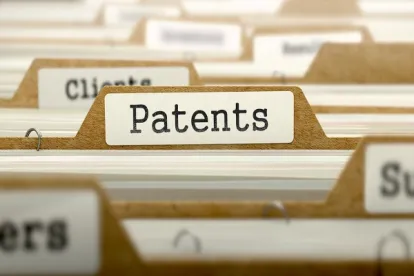In an appeal characterized as “unusual,” the Federal Circuit affirmed the grant of a preliminary injunction, holding it likely that plaintiff patent holder would succeed on the merits its claim of infringement of a patent claiming a purified chemical compound, but reversed a finding of infringement under the doctrine of equivalents of related chemical process patents. Mylan Institutional LLC v. Aurobindo Pharma Ltd., 2017-1645 (May 19, 2017 Fed. Cir.). The decision is an interesting read because, as the court admitted, “of the sparse and confusing case law concerning equivalents, particularly the paucity of chemical equivalents case law, and the difficulty of applying the legal concepts to the facts.” Slip Op at 12.
Processes for Preparing Isosulfan Blue (ISB) and the ISB Product
Apicore is the owner of three patents: U.S. Patent Nos. 7,622,992 (‘992 Patent) and 8,969,616 (‘616 Patent) that relate to processes for preparing isosulfan blue (“ISB”), and U.S. Patent No. 9,353,050 (‘050 Patent) that claims a purified compound having greater than 99% purity as measured by high performance liquid chromatography (HPLC). All three patents share the same patent specification. Mylan Institutional LLC (Mylan) is the exclusive licensee of the three patents.
ISB is a dye for mapping lymph nodes. The ‘992 and ‘616 Patents relate to a process for preparing ISB by reacting isoleuco acid with silver oxide in a polar solvent. The product is subsequently reacted with a sodium solution. The claims of the ‘616 and ‘992 Patents are identical, except the ‘992 Patent also requires 2.0-3.0 equivalents of silver oxide.
Apicore’s patented process produces ISB having a purity greater than prior art ISB products. Apicore received FDA approval to market the product and ultimately, competitors abandoned the market.
Defendant Aurobindo also sought FDA approval for an ISB product and told the FDA that it had studied the ‘992 Patent and that it had optimized the claimed process by substituting manganese dioxide for silver oxide used in the ‘992 Patent process. Aurobindo also used HPLC to achieve a purity of greater than 99.5%.
Mylan sued Aurobindo for infringement and sought a preliminary injunction, which the Eastern District of Texas granted.
Infringement Under the Doctrine of Equivalents and Injunctive Relief
Aurobindo sought on appeal reversal of the district court’s finding that Aurobindo more likely than not infringed the ‘616 and ‘992 Patents under the doctrine of equivalents.
A court will grant a preliminary injunction only when the plaintiff can establish “that [the plaintiff] is likely to succeed on the merits, that he is likely to suffer irreparable harm in the absence of preliminary relief, that the balance of equities tips in his favor, and that an injunction is in the public interest.” Slip Op. at 10, citing, Winter v. Natl. Res. Def. Council, Inc., 555 U.S. 7, 20 (2008). With that in mind, on appeal the Federal Circuit evaluated the district court’s finding of infringement under the doctrine of equivalents.
Aurobindo argued that it had raised a substantial question of infringement of the ‘616 and ‘992 process Patents, because the use of manganese dioxide is different from the use of silver oxide claimed in the patents. Manganese dioxide is a stronger oxidizing agent and requires the use of an acid, which the patents specifically report is not necessary with the use of silver oxide. Aurobindo also disputed Mylan’s argument (supported in large part by an expert testimony), that if “manganese dioxide was a substantially stronger oxidizing agent than silver oxide, a skilled artisan ‘would expect different results.’” Slip Op. at 11.
The Federal Circuit agreed with Aurobindo that the district court’s analysis was erroneous. The court first noted that in chemical cases, the function-way-result (FWR) test (“viz., whether the accused product performs ‘substantially the same function in substantially the same way to obtain the same result’” Slip Op. at 12) is not well suited for the chemical arts. The court noted that for chemical cases, the insubstantial differences test (“whether the accused product or process is substantially different from what is patented”) may be more suitable.
The Federal Circuit determined that the “function” prong of the FWR test was not met because of the difference in oxidation strength between silver oxide and manganese dioxide was not considered by the district court. In addition, the Federal Cirsuit held that the district court erred in failing to address the “way” prong of the FWR analysis – “having considered the relative oxidation strengths to be an issue for claim construction, and rejecting Aurobindo’s arguments about oxidation strength because it had not argued for a narrow claim construction – or it performed a ‘way’ analysis without considering critical factors under the prong, namely, the relative oxidation strengths of silver oxide and manganese dioxide, as well as the use of an acid in the accused process.” Slip Op. at 15-16.
The Federal Circuit determined that manganese dioxide and silver oxide do not function in the same way, noting the relative oxidation strengths of the two oxidizing agents and the fact that manganese dioxide requires the use of an acid for oxidation, while silver oxide does not. The court concluded that “[t]hus, there is room for sufficient doubt as to whether silver oxide and manganese dioxide oxidize isoleuco acid in the same way so as to satisfy the ‘way’ prong of the FWR test.” Slip Op at 16.
As a tutorial, the court went on to illustrate how the FWR test is ill suited for chemical patents. Taking aspirin and ibuprofen, two structural different compounds, as an example, the court noted that the compounds could be considered equivalents under the FWR test because they each provide analgesia and anti-inflammatory activity (“function”) by inhibiting prostaglandin synthesis (“way”) in order to alleviate pain, and reduce fevers and inflammation (“result”). In contrast, under the substantial differences test, the distinct chemical structures of the two compounds would establish that they are not equivalents.
Applying the substantial differences test to the facts at hand, the Federal Circuit noted that manganese dioxide and silver oxide are substantially different in many respects. They are in different groups of the Periodic Table and they have different oxidation states. Slip Op at 18. Thus, under this test, they are not equivalents.
The Product Patent
Aurobindo had challenged the validity of the ‘050 Patent on three grounds: 1) that the claims were anticipated by the prior sale of a similar product by Sigma; 2) that the claims were over obvious over the prior art; and 3) that the claims were indefinite in reciting the term “having a purity of at least 99% by HPLC.”
On anticipation, Aurobindo’s challenge failed because the court found that the evidence supporting the anticipation argument was not credible. Aurobindo relied on Sigma’s manufacturing literature that was determined to be unclear and contradicted by other Sigma literature.
The Federal Circuit also found the obviousness argument without merit because the process to obtain the compound of the ‘050 Patent was itself of patentable weight, and thus the claims would not have been prima facie obvious over the prior art.
The Federal Circuit rejected the indefiniteness argument noting that HPLC is a well-known and common means to determine purity.
Finally, the court gave weight to Mylan’s evidence of secondary considerations supporting non-obviousness of the patent of long-felt but unmet need, commercial success, copying/praise of others, and unexpected results.
Preliminary Injunctive Relief
While Aurobindo prevailed in reversing the finding of infringement under the doctrine of equivalents of the ‘616 and ‘992 Patents, its failure to reverse the finding of validity of the ‘050 Patent led them to the same place – their manufacture and sale of ISB was enjoined.




 />i
/>i

